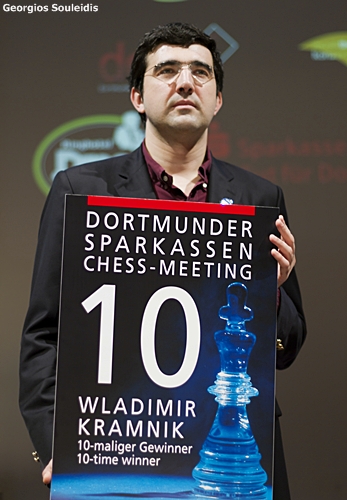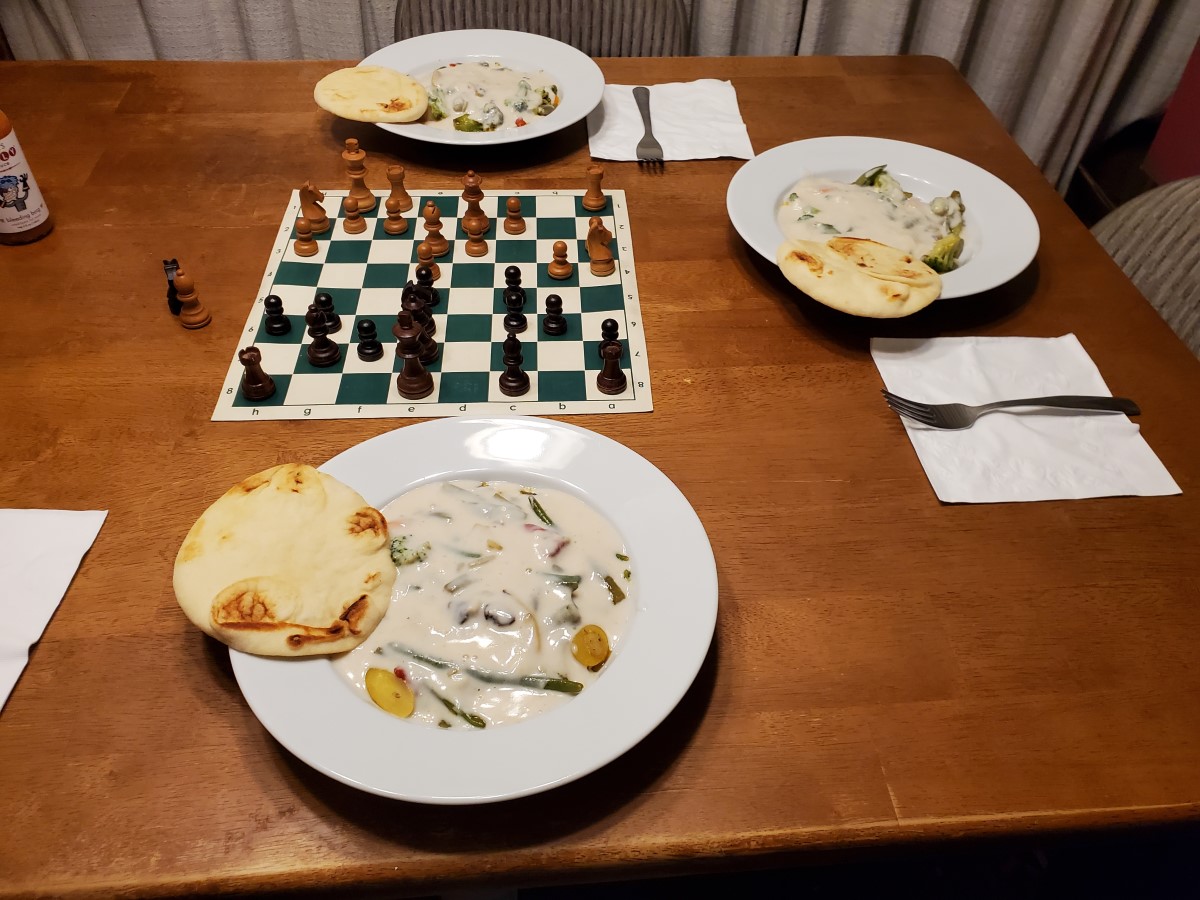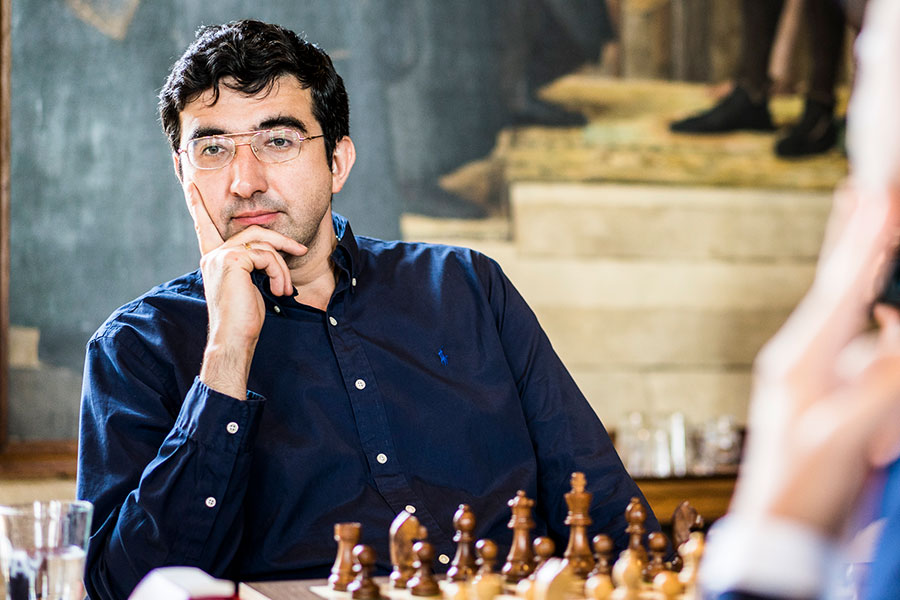The early years
Kramnik’s first big win was as first alternate for the 1992 Russian Olympic team, when he was the only team member that was not a Grandmaster. It took the support of Kasparov for him to be on the team ahead of their second alternate, GM Alexey Vyzmanavin. He scored eight wins, one draw, and no losses, a performance of 2958, which won a gold medal for best rating performance.
World chess champion
Kramnik was one of the world’s top players in the mid to late 90s but did not qualify for a world title match until 2000, when Kasparov gave him a shot at his.
Kramnik defeated Kasparov; then defended his title in 2004 against Péter Lékó; and defeated the reigning FIDE World Champion Veselin Topalov in a unification match in 2006.
He lost his title in 2008 to Anand.
Retirement
 Vladimir continued playing chess at a very high level, qualifying for the Candidates and winning top flight chess tournaments until he retired from classical chess in 2019. He has focused on chess projects related to scholastic education, but has returned to the board for an occasional rapid, blitz or simultaneous event.
Vladimir continued playing chess at a very high level, qualifying for the Candidates and winning top flight chess tournaments until he retired from classical chess in 2019. He has focused on chess projects related to scholastic education, but has returned to the board for an occasional rapid, blitz or simultaneous event.
Now that Kramnik's world champion days have been behind him for a while, we have seen him keeping busy in recent years by playing and acting as a second for Anand, who he still has an even score against. The careers of these two titans of the modern chess world have been closely entwined. Susan Hinan of ESPN points out that the year Kramnik ended Kasparov’s reign as world champion in 2000 was also the one that rung in Anand’s first world title. They have often found each other in the way of their most prized ambitions and dreams, most notably that of the world championship. Back when the chess world and the world title were split, they were the ones who held the halves of the world championship belt. When they finally did clash, it was Anand who walked away the victor. But the struggle did not diminish Kramnik, who will always be the man who beat the unbeatable Garry Kasparov.
[Pictured: Kramnik in Dortmund | Photo: Georgios Souleidis]
The recipe
In the Microsense Kramnik Gelfand Chess Program, Chef Talwar describes what he made to feed our champion. Based upon information in this video, I decided to make Veggies in Indian White Sauce. While I have written step-by-step instructions, you may find this video helpful.
Ingredients
 Double rook endings occur frequently and are different from single rook endings in several respects.
Double rook endings occur frequently and are different from single rook endings in several respects.White Sauce
- ¼ cup butter
- ¼ cup all-purpose flour
- 3 cups whole milk
- ½ onion
- 6 cloves
- 1 bay leaf
- 1 pinch white pepper
- salt to taste
- ground nutmeg to taste (optional)
Veggie Stir Fry
Choose whatever fresh vegetables you want in the quantity you want. For my meal I chose:
- broccoli flowerets
- sugar snap peas
- green beans
- red peppers
- carrots
- onions
- 2 tablespoons peanut oil
- 1 tablespoon ground turmeric
Directions
- Heat the milk to a simmer in a pan you can pour from, then remove from heat.
- Melt the butter with medium to low heat in a separate saucepan.
- Once the butter is melted, add the flour, stir with a wooden spoon or a spatula until roux (flour and fat thickening agent) is formed. Continue stirring, cooking but not browning the flour for another minute.
- Remove from the heat source and wet the roux with a little milk while constantly stirring. Keep adding milk a little at a time until it becomes a paste. Return to medium heat, keep adding and stirring until you have a smooth mixture then you can add the remainder of the milk without fear of a lumpy sauce.
- Stud the onion with the cloves and add it to the sauce, along with, the bay leaf, the white pepper, and an optional pinch of nutmeg and/or salt.
- Simmer for 15 minutes, remove from heat and remove the clove studded onion and bay leaf.
- Add peanut oil to a hot skillet and add your vegetables.
- Once the vegetables are frying, add the turmeric and continue stir frying until you reach your desired level of cooking, I did this for 8 minutes.
- Plate vegetables and cover with white sauce.

The game
The opening phase of the chosen game is just like making a bechamel sauce as both sides can influence what type of flavor the game gets, from basic and creamy to cheesy or spicy.
This DVD allows you to learn from the example of one of the best players in the history of chess and from the explanations of the authors (Pelletier, Marin, Müller and Reeh) how to successfully organise your games strategically, consequently how to keep y
Links


















 Vladimir continued playing chess at a very high level, qualifying for the Candidates and winning top flight chess tournaments until he
Vladimir continued playing chess at a very high level, qualifying for the Candidates and winning top flight chess tournaments until he 





